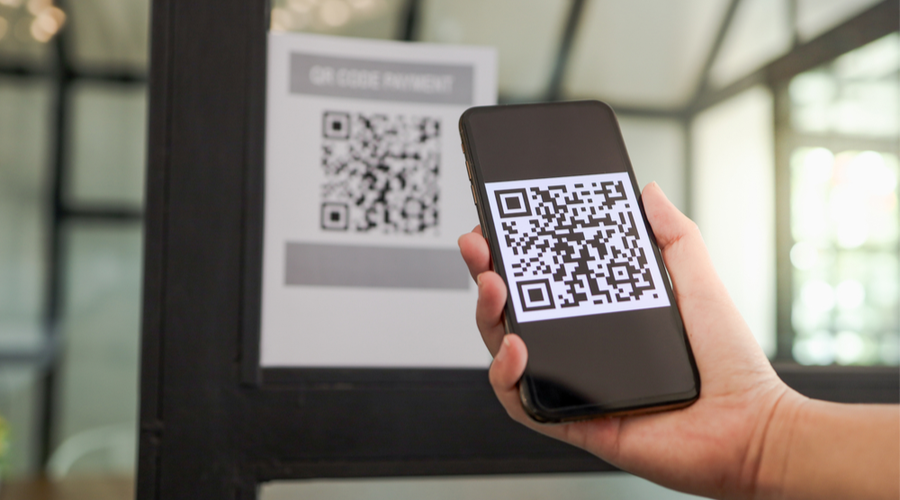By now, most of your patients can immediately recognize a QR, or Quick Response, code. “How I used to describe it to my mother was a pretty little black and white square with lots of other little squares on the inside,” said Maryann Moschides, chief marketing officer and general manager at Scanbuy, Inc., a mobile engagement company that helps companies of all sizes take advantage of QR code technology.
The pandemic helped launch the QR code into the stratosphere. They can be seen on boarding passes, in restaurants to connect to a menu, and even in television commercials. “Almost everyone has a smartphone that can scan a QR code, even our parents and grandparents,” Moschides said.
The ubiquity of this technology means it can be a potent tool for marketing your pharmacy. Because the pandemic has given your patients a crash course in how to interact with QR codes, you don’t even have to provide as much education. Simply use QR codes to further your marketing message. “We’ve found that retailers and brands have recognized the value of the QR code to engage with customers and improve the business environment for them,” Moschides said.
Here’s how you can effectively implement QR codes in your pharmacy.
QR Code Basics
There are many ways you can use QR codes in the pharmacy, but the end goal should always be the same: making things easier for your patients.
“When you’re in an environment where there aren’t always employees standing next to the shopper to answer questions or give information, that’s where QR codes can come in handy,” said Moschides. QR codes can also be used to direct patients to digital resources. If you have a pharmacy app, you can give them a flier with a QR code on it that will help them download the app quickly. It’s a seamless process with fewer steps than asking them to type in a specific URL or search for it in an app store.
Additionally, QR codes can be used to create even more touchpoints with patients. “We find that for folks who are trying to grow their mailing lists, QR codes can be a good shortcut,” Moschides said. “You can have people scan to join a loyalty program or scan for more coupons, and then people give you permission to email them or text them. It helps you find the people who really want to engage with your brand.”
No matter how you use QR codes, where you place them in your pharmacy can make or break their effectiveness.
Research your traffic patterns to learn how people move through your store and find out where they’re walking or waiting. When patients are waiting for prescriptions, their eyes will naturally drift to signage in the environment, and they’ll be especially receptive to a QR code. They can be placed on shelf talkers, on display cases, or at the register when patients are checking out.
Even outside your pharmacy waiting area, there are places in the front end where patients are more likely to linger, and that’s where QR codes can be effectively deployed. “When you have signs while they’re staring at options and deciding what to pick up, like in a fridge or freezer section, that’s where they may scan more often,” Moschides said. When you understand where your patients are spending the most time, you can create a strategy to reach them with QR codes at the right point in their shopping journey.
When you think about QR code placement, be sure it’s in a location that is easy to see and scan. You can create a beautiful poster with a great call-to-action and a large QR code, but no one will engage with it if the poster is hidden in a corner or obscured by a plant. “We’ve seen brands put codes on display cases or high on shelves where consumers can’t really access it,” Moschides said. “You have to be thoughtful, because if it’s in the wrong place, the marketing campaign could fail, and it has nothing to do with the QR code.”
Scan to Apply
Patients aren’t the only people you can reach with QR codes. They can also be used to reach potential employees. With retail pharmacies facing a worker shortage, making your application process available and accessible will help you reach more candidates. “When you pair it with a sign that says, ‘We’re hiring,’ you can link a QR code to an application that makes it easy for candidates to submit resumes and apply for positions,” said Moschides.
Quick QR Statistics
87% of people have scanned at least one QR code in their lifetime
37% of people scan a QR code at least once a week
91% of iPhone users have a built-in QR scanner
5.3 billion QR code coupons will be redeemed in 2022
Sources: MobileIron; Apple; Juniper Research
Mastering Messaging
Placement isn’t the only important thing to think about when putting QR codes in your pharmacy. You also need a compelling message that aligns with your current marketing strategy.
“You need to have messaging that is encouraging and inspiring, and really jumps out,” Moschides said. “Something like, ‘Scan this to schedule an appointment,’ or ‘Scan to win,’ will really catch people’s attention.”
She says the biggest mistake companies make is not including a call to action with their QR codes. “No call to action, nobody will scan it.” If there is a lone QR code, people will assume it’s a UPC code or exists for some logistical purpose.
“It’s really about creating a marketing message that gets people to do more,” Moschides explained. “You don’t want them to just read a couple lines of text and move on. You really want people to continue to engage.”
Don’t be afraid to get creative with QR codes. One way to get patients to interact with the code is by tying it to a contest or giveaway. “Contests always get scans,” Moschides said. “It’s just human. People want to be a part of something, so they will scan for the chance to win.” Create a QR code scavenger hunt or have patients scan a code to be entered into a giveaway. This is also a good way to collect email addresses and further expand your marketing reach.
You don’t have to limit QR codes to in-store experiences, either. Include them on direct mail or outdoor advertisements like billboards to catch people’s attention during their day-to-day life. Some businesses are even including QR codes in TV commercials—and seeing scans in impressive numbers. “People are sitting on the couch watching TV, and they almost always have their phones with them,” Moschides pointed out.
What About QR Code ROI?
To make the most of your QR code marketing, take advantage of dynamic, or trackable, QR codes.
- Number of scans
- When scans took place
- What devices people are using
- Which codes are being scanned
With this data, you can tailor your QR code strategy to your patients’ scanning habits.
Using a dynamic QR code, you can perform A/B testing to determine which marketing messages are encouraging people to scan. You can also identify hotspots—you may discover patients are scanning most often when they are standing in the pharmacy waiting area or idling in the drive-thru lane, but they hardly ever scan the code at the register.
The analytics available to you will depend on which QR code provider you choose, so do your research before committing to a plan.
Logistics
When you’re placing a QR code, you also need to think about how big it needs to be. “It all depends on where the shoppers are scanning the code from,” Moschides explained. The farther away they are, the larger it needs to be. For a code on the back of a receipt, you can create a code that’s half an inch by half an inch, but never go any smaller, because some phone cameras won’t be able to scan the image.
The rule of thumb is a QR code should be sized based on a 1:10 ratio—for every 10 inches away a person is, the code needs to be one inch wide. So, if a code is designed to be scanned from five feet away, it should be at least six inches wide.
Also be conscious of color. There should be enough contrast that the code is immediately visible to patients. “I noticed a retailer recently that put a light gray QR code on a glass window of their store,” Moschides said. “You could see that there was a sticker there, but you couldn’t read the message or scan the code. It was basically invisible.”
Don’t forget about the user experience on the other end of the QR code, either. Essentially everyone will be using their phone to scan the code, so it is critical to design your QR code experience for mobile. “If you don’t have a mobile-friendly website, you’ll just disappoint the scanner,” said Moschides.
Expand Your Reach
Use these QR code strategies to share information with your patients and collect data to help you improve pharmacy services.
Store information: Place a QR code in your pharmacy window so patients can learn more about your hours, safety practices, current promotions, or other pharmacy procedures.
Product information: Use QR codes on hangtags or shelf-talkers so patients can find out more about the products on your shelves.
Online connection: Create a QR code that immediately connects in-store shoppers to your pharmacy app or social media pages.
Appointment scheduling: Patients who want to schedule an appointment for pharmacy services can scan a QR code.
Feedback collection: Use QR codes to direct patients to a customer satisfaction survey.
Creative engagement: Put together a QR code scavenger hunt or contest with a tempting prize.
Payments: QR codes can be used to combine a touchless payment experience with customer loyalty perks.
From the Magazine
This article was published in our quarterly print magazine, which covers relevant topics in greater depth featuring leading experts in the industry. Subscribe to receive the quarterly print issue in your mailbox. All registered independent pharmacies in the U.S. are eligible to receive a free subscription.
More articles from the June 2022 issue:
- Cultivating Your Leadership Style
- Semglee Is Now Available at Retail Pharmacies
- Tackling Burnout in the Pharmacy
- Refresh Your Pharmacy With a Remodel
- Modern Marketing with QR Codes
- Profitable Expansion with Remote Delivery Kiosks
- Choosing the Right Accounting Method
- Measuring and Maximizing Wholesaler Rebates
A Member-Owned Company Serving Independent Pharmacies
PBA Health is dedicated to helping independent pharmacies reach their full potential on the buy-side of their business. Founded and run by pharmacists, PBA Health serves independent pharmacies with group purchasing services, wholesaler contract negotiations, proprietary purchasing tools, and more.
An HDA member, PBA Health operates its own NABP-accredited warehouse with more than 6,000 SKUs, including brands, generics, narcotics CII-CV, cold-storage products, and over-the-counter (OTC) products — offering the lowest prices in the secondary market.












